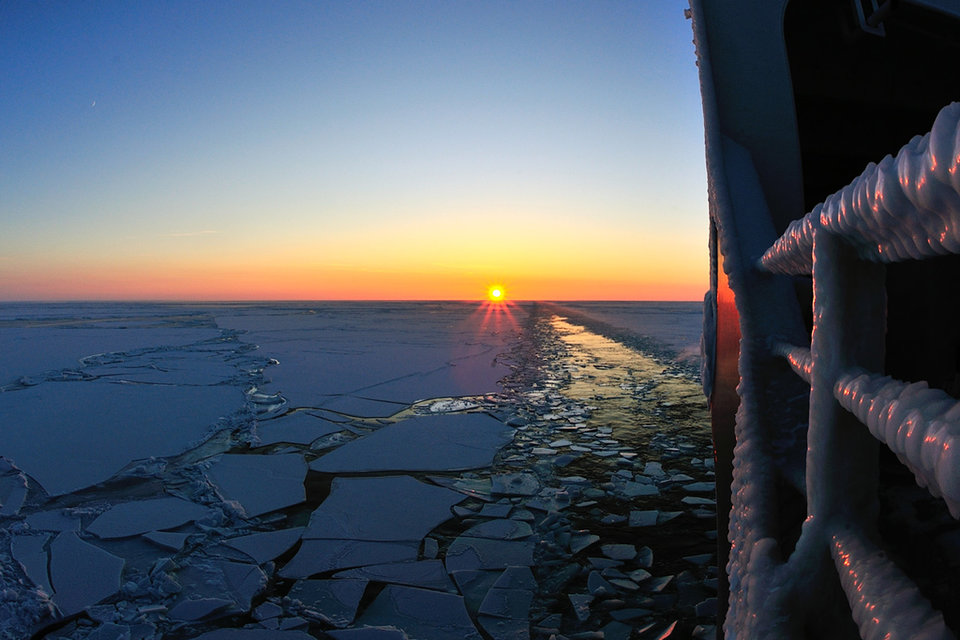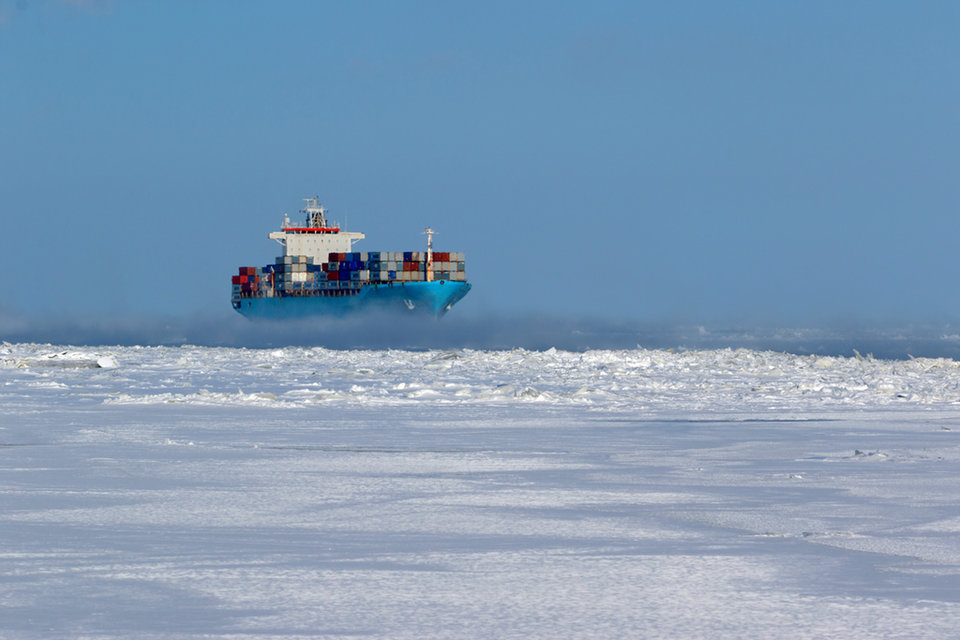Safety
Rough waters:
inside the new Guideline for Arctic Marine Risk Assessment
The Arctic Council’s Emergency Prevention, Preparedness and Response Working Group has released its first Guideline for Arctic Marine Risk Assessment. As the most comprehensive guide on Arctic navigation yet, the document provides tailored data and tools to improve safety in the region. Adele Berti finds out more.
Image:
The Arctic region
is a predominantly oceanic area spread around the North Pole and encompassing several countries, including Iceland, Greenland, Alaska, Canada, Russia and Norway. The average temperature in this part of the world, which is home to over 21,000 species, is 10°C due to the vast presence of sea ice throughout its surface.
Sailing in these waters is anything but easy. The Arctic is hardly a hospitable environment with its low temperatures, long spans of darkness, icebergs and unpredictable weather conditions. Yet, as the years go by, passenger and cargo traffic continues to increase in the area, simultaneously jeopardising the fragile Arctic ecosystems and those who sail through it. These dangers were recently outlined in the 'Guideline for Arctic Marine Risk Assessment', a document published by the Emergency Prevention, Preparedness and Response (EPPR) Working Group of the Arctic Council.
Developed on the back of the International Maritime Organization’s (IMO) International Code for Ships Operating in Polar Waters (also known as the Polar Code) and its Risk Matrix, the paper is the first in the world to focus solely on the Arctic. It also offers risk assessment tools specifically crafted for the Arctic region and its characteristics, as well as best practice methods and data sources to carry out these assessments when planning trips in the area.
Those who worked on the guideline say that it attempts to bridge the knowledge gap that has been limiting the industry’s operational capabilities. It does this primarily by detailing practical ways of making decisions before sailing on these fascinating yet highly dangerous waters.
Shifting the focus from both poles to the Arctic alone
Much like the Polar Code, the EPPR’s guidelines provide a range of best practice methods to identify navigation risks inherent to both the Arctic environment and those who sail through it, though with two key differences.
First, while the Polar Code is intended for Polar regions - and therefore includes the Antarctic - the EPPR’s version focuses solely on the Arctic seas. This is a first for the industry, which had been previously forced to rely on generic risk factors found in global waters.
Most of the existing risk assessment and the methodology concerning it do not incorporate specific Arctic risk factors
“Most of the existing risk assessment and the methodology concerning it do not incorporate specific Arctic risk factors,” explains Trine Beate Solevaagseide, international coordinator at the Maritime Safety Department of the Norwegian Coastal Administration Head Office, a member of the Arctic Council. “So we wanted to look at these factors and see if we could incorporate them for [anyone wanting] to carry out a risk assessment for the Arctic.”
Another difference is who the guidelines are aimed at. While the Polar Code has been designed to support shippers and operators, its Arctic counterpart targets regulatory bodies and other decision-makers. As Andreas Kjøl, senior adviser at the Norwegian Coastal Administration Head Office’s Maritime Safety Department, explains: “These guidelines are more for stakeholders in ports, intergovernmental organisations and consultancies, but also shipping companies who can use them as a bank of information.”

Image:
The risks of sailing in the Arctic and the factors shaping them
Available to the general public, the document outlines six steps to follow during the risk assessment process - starting from ‘scope, context, and criteria’ and concluding with a ‘report’.
“[The guide] breaks down details on some of the information that is addressed in the Polar Code, makes it more understandable and [puts it] in a usable format,” says Kjøl. “It also looks at the start of the process, so it can help operators and organisations to understand the risks and challenges they could have.”
The document further mentions ten so-called risk influencing factors that need to be kept in consideration prior to sailing in Arctic waters. These include ice, topside icing, low temperature, high latitude, remoteness, lack of crew experience, lack of emergency equipment, severe weather conditions, the environment, and extended periods of darkness or daylight.
There is anything from the remoteness factor to ice in many forms
“There is anything from the remoteness factor, which relates to a ship’s distance from search and rescue authorities [...] to ice in many forms, like icebergs, drifting ice, topside icing on the ships,” says Solevaagseide. "The consequences of an accident in the Arctic are often more severe than other places due to the sensitive environment that you can find out there.”
However, despite fully covering the planning part of the process, the guideline fails to cover mitigating measures. According to Kjøl, this is something that could be considered in the coming years.
“The risks are addressed but the ‘evaluation’, ‘treatment’ and ‘report’ sections [so the last three steps] are not totally finished,” he adds. “However, the guideline still gives a great understanding of these risks and how [proper knowledge of them] can help [improve performance]. Mitigation will probably be the next level of this project, depending on funding.”

How risk is expected to change in the coming decades
According to Kjøl, risk in the region varies based on location, seasons and several other elements including traffic rates, which have increased by 25% in the last six years.
The growing popularity of Arctic shipping is exacerbating exposure to risk and making planning ahead much more challenging. “These rapidly changing conditions can lead to a potential escalation of incidents,” he says, “but remoteness and governmental rescue abilities are also very much at risk, especially compared to other places that might have better infrastructure.”
In the years to come, he fears that managing these risks will become tougher as visitors unprepared for northern maritime operations increase in number.
Recent research from another branch of the Arctic Council, the Protection of the Arctic Marine Environment (PAME) Working Group, is further testament to this claim. The first of its kind for the Arctic Council, the Arctic Shipping Status Report analysed regional shipping trends between 2013 and 2019.
Sail distance has increased 75%, while the rate of fishing has gone up 41%
“Sail distance has increased [by] 75%, while the rate of fishing has gone up 41%,” says Kjøl. Other findings show that while fishing vessels represented the majority of traffic in that period, some 73 cruise ships also sailed in Arctic waters. Finally, the distance sailed by bulk carriers in the area rose 160% between 2013 and 2019.
“If it continues to be business as usual while traffic increases, the risks will grow proportionally,” he continues. “We have to understand this and then come up with mitigating measures for operators, [who] have to understand what this area is about and know what can be expected in the Arctic.”
In the long term, even more and varied changes should further be expected. “We’ll have much more ability and much more unpredictability,” he concludes. “Seasonal and annual differences will increase and they will make it much harder for operators to plan their trips.”
“Sea ice and icebergs are much more movable and are in places where we haven’t seen them before, and maybe even ice in areas where we have never seen it before so all these things are more unpredictable and that’s an entirely new perspective.”